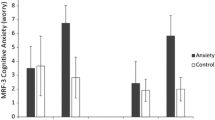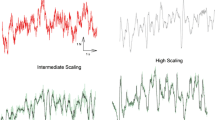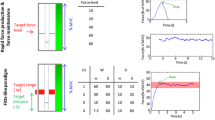Abstract
This experiment was set up to investigate the influence of constant and variable practice on performance accuracy and the time- and frequency-dependent structure of the force output dynamics in the learning of an irregular isometric force pattern. Traditional approaches to the variability of practice hypothesis have demonstrated benefits of task-induced variability at the outcome level of behavior, but there have been limited investigations of the effect of practice conditions on movement execution and particularly the multiple time scale processes of force output. During the practice phase, variability was induced along the force–time dimension of the target pattern for the variable practice condition (different wave forms), but the wave forms exhibited the same distributional properties of the frequency content (1/f noise: β = −1.5) as the constant practice condition. The results showed that both practice conditions exhibited similar reductions in task error as a function of practice. However, constant practice produced greater changes in the time- and frequency-dependent properties of force output than variable practice, including a higher relative change in the contribution from faster (4–12 Hz) time scale mechanisms. Generalization tests to novel target patterns revealed that the task dynamics had a greater influence than the effect of practice conditions. Collectively, the findings support the adaptive nature of force output structure and the perspective that practice conditions can produce differential effects on the outcome and execution levels of motor behavior.






Similar content being viewed by others
References
Bachman JC (1961) Specificity vs. generality in learning and performing two large muscle motor tasks. Res Q 32:3–11
Bernstein NA (1967) The co-ordination and regulation of movements. Pergamon Press, Oxford
Braun D, Aertsen A, Wolpert D et al (2009) Motor task variation induces structural learning. Curr Biol 19:352–357
Coelho CJ, Nusbaum HC, Rosenbaum DA et al (2012) Imagined actions aren’t just weak actions: task variability promotes skill learning in physical practice but not in mental practice. J Exp Psychol Learn Mem Cog 38:1759–1964
Desmurget M, Grafton S (2000) Forward modeling allows feedback control for fast reaching movements. Trends Cogn Sci 4:423–431
Duchateau J, Semmler JG, Enoka RM (2006) Training adaptations in the behavior of human motor units. J Appl Physiol 101:1766–1775
Henry FM (1968) Specificity vs. generality in learning motor skill. In: Brown RC, Kenyon GS (eds) Classical studies on physical activity. Englewood Cliffs, NJ: Prentice-Hall, pp 328–331
Heuer H, Schmidt RA (1988) Transfer of learning among motor patterns with different relative timing. J Exp Psychol Hum Percept Perform 14:241–252
Karni A, Sagi D (1993) The time course of learning a visual skill. Nature 365:250–254
Keetch KM, Schmidt RA, Lee TD et al (2005) Especial skills: their emergence with massive amounts of practice. J Exp Psychol Hum Percept Perform 31:970–978
Kerr R, Booth B (1978) Specific and varied practice of motor skill. Percept Mot Skills 46:396–401
Mechsner F, Kerzel D, Knoblich G et al (2001) Perceptual basis of bimanual coordination. Nature 414:69–73
Miall R, Weir D, Stein J (1985) Visuomotor tracking with delayed visual feedback. J Neurosci 16:511–520
Moxley SE (1979) Schema: the variability of practice hypothesis. J Mot Behav 11:65–70
Newell KM, Vaillancourt DE (2001) Dimensional change in motor learning. Hum Mov Sci 20:695–715
Newell KM, Liu YT, Mayer-Kress G (2001) Time scales in motor learning and development. Psychol Rev 108:57–82
Newell KM, Broderick MP, Deutsch KM et al (2003) Task goals and change in dynamical degrees of freedom with motor learning. J Exp Psychol Hum Percept Perform 29:379–387
Pew RW (1974) Levels of analysis in motor control. Brain Res 71:393–400
Pincus SM (1991) Approximate entropy as a measure of system complexity. Proc Natl Acad Sci USA 88:2297–2301
Pressing J, Jolley-Rogers G (1997) Spectral profiles of human cognition and skill. Biol Cybern 76:339–347
Proteau L (1992) On the specificity of learning and the role of visual information for movement control. In: Proteau L, Elliott DE (eds) Vision and motor control. North Holland, Elsevier, pp 67–104
Ranganathan R, Newell KM (2010a) Emergent flexibility in motor learning. Exp Brain Res 202:755–764
Ranganathan R, Newell KM (2010b) Motor learning through induced variability at the task goal and execution redundancy levels. J Mot Behav 42:307–316
Rhea CK, Wutzke CJ, Lewek MD (2012) Gait dynamics following variable and constant speed gait training in individuals with chronic stroke. Gait Posture 36:332–334
Rochet-Capellan A, Richer L, Ostry DJ (2011) Non-homogeneous transfer reveals specificity in speech motor learning. J Neurophys 107:1711–1717
Schmidt RA (1975) A schema theory of discrete motor skill learning. Psychol Rev 82:225–260
Schmidt RA, Young DE (1987) Transfer of movement control in motor skill learning. In: Cormier SM, Hagman JD (eds) Transfer of learning: contemporary research and applications. The educational technology series. San Diego, Academic Press, pp 47–79
Schmidt RA, Lee TD (2005) Motor control and learning: a behavioral emphasis. Human Kinetics, Champaign
Shapiro D, Schmidt RA (1982) The schema theory: recent evidence and developmental implications. In: Kelso JAS, Clark JE (eds) The development of movement control and co-ordination. Wiley, New York, pp 113–150
Shea JB, Morgan RL (1979) Contextual interference effects on the acquisition, retention, and transfer of a motor skill. J Exp Psychol Learn Mem Cog 5:179–187
Slifkin AB, Vaillancourt DE, Newell KM (2000) Intermittency in the control of continuous force production. J Neurophys 84:1708–1718
Sosnoff JJ, Newell KM (2005) Intermittent visual information and the multiple time scales of visual motor control of continuous isometric force production. Percept Psychophys 67:335–344
Sosnoff JJ, Voudrie SJ (2009) Practice and age-related loss of adaptability in sensorimotor performance. J Mot Behav 41:137–146
Sosnoff JJ, Valantine AD, Newell KM (2009) The adaptive range of 1/f isometric force production. J Exp Psychol Hum Percept Perform 35:439–446
Stephen DG, Stepp N, Dixon JA et al (2008) Strong anticipation: sensitivity to long-range correlations in synchronization behavior. Phys A 387:5271–5278
Tulving E, Thomson DM (1973) Encoding specificity and retrieval processes in episodic memory. Psychol Rev 80:352–373
Turnham EJ, Braun DA, Wolpert DM (2012) Facilitation of learning induced by both random and gradual visuomotor task variation. J Neurophys 107:1111–1122
Van Rossum JHA (1990) Schmidt’s schema theory: the empirical base of the variability of practice hypothesis. Hum Mov Sci 9:387–435
Woodworth RS (1899) Accuracy of voluntary movement. Psychol Rev 3:1–114
Author information
Authors and Affiliations
Corresponding author
Rights and permissions
About this article
Cite this article
King, A.C., Newell, K.M. The learning of isometric force time scales is differentially influenced by constant and variable practice. Exp Brain Res 227, 149–159 (2013). https://doi.org/10.1007/s00221-013-3446-z
Received:
Accepted:
Published:
Issue Date:
DOI: https://doi.org/10.1007/s00221-013-3446-z




